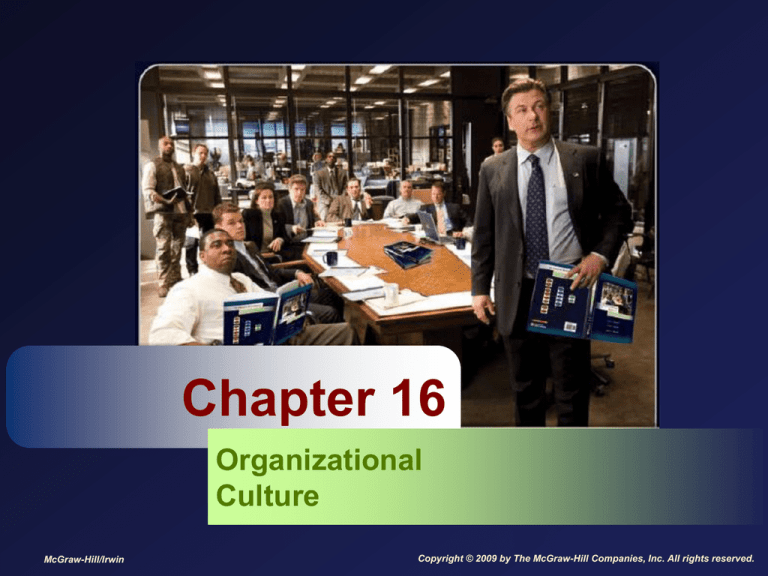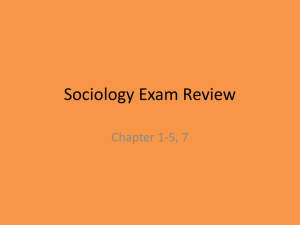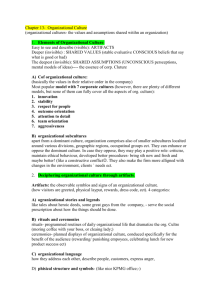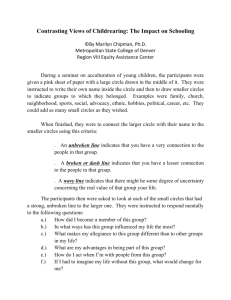
Chapter 16
Organizational
Culture
McGraw-Hill/Irwin
Copyright © 2009 by The McGraw-Hill Companies, Inc. All rights reserved.
Learning Goals
What is organizational culture, and what are its
components?
What general and specific types can be used to describe
an organization’s culture?
What is a strong culture, and what makes a culture
strong? Is a strong culture necessarily good?
How do organizations maintain their culture? How do they
change it?
What is person–organization fit? How does fitting with an
organization’s culture affect job performance and
organizational commitment?
What steps can organizations take to make sure that
newcomers will fit with their culture?
Slide
16-2
Organizational Culture
Organizational culture is the shared social
knowledge within an organization regarding the
rules, norms, and values that shape the attitudes
and behaviors of its employees.
Culture is social knowledge among members of the
organization.
Culture tells employees what the rules, norms, and
values are within the organization.
Organizational culture shapes and reinforces certain
employee attitudes and behaviors by creating a
system of control over employees.
Slide
16-3
Culture Components
Observable artifacts are the manifestations of an
organization’s culture that employees can easily
see or talk about.
Symbols can be found throughout an organization, from
its corporate logo to the images it places on its Web site
to the uniforms its employees wear.
Physical structures are the organization’s buildings
and internal office designs.
Language reflects the jargon, slang, and slogans used
within the walls of an organization.
Slide
16-4
Culture Components, Cont’d
Observable artifacts, continued
Stories consist of anecdotes, accounts, legends, and
myths that are passed down from cohort to cohort
within an organization.
Rituals are the daily or weekly planned routines that
occur in an organization.
Ceremonies are formal events, generally performed
in front of an audience of organizational members.
Espoused values are the beliefs, philosophies,
and norms that a company explicitly states.
Published documents, verbal statements made to
employees by managers.
Slide
16-5
Adapted from Table 16-1
The Espoused Values of UPS
Slide
16-6
Culture Components, Cont’d
Basic underlying assumptions are
taken-for-granted beliefs and philosophies
that are so ingrained that employees
simply act on them rather than questioning
the validity of their behavior in a given
situation.
Slide
16-7
Figure 16-1
The Three Components of
Organizational Culture
Slide
16-8
General Culture Types
Fragmented culture is an organizational culture type in
which employees are distant and disconnected from one
another.
Mercenary culture is an organizational culture type in
which employees think alike but are not friendly to one
another.
Communal culture is an organizational culture type in
which employees are friendly to one another, but
everyone thinks differently and does his or her own
thing.
Networked culture is an organizational culture type in
which employees are friendly to one another and all think
alike.
Slide
16-9
Figure 16-2
A Typology of Organizational
Culture
Slide
16-10
Specific Culture Types
Customer service culture is a specific
culture type focused on service quality.
Figure 16-3
Slide
16-11
Specific Culture Types, Cont’d
Safety culture is a specific culture type focused
on the safety of employees.
A positive safety culture has been shown to reduce
accidents and increase safety-based citizenship
behaviors.
Diversity culture is a specific culture type
focused on fostering or taking advantage of a
diverse group of employees.
Creativity culture is a specific culture type
focused on fostering a creative atmosphere.
Slide
16-12
Discussion Questions
Have you or a family member worked for
an organization that you would consider to
have a strong culture?
If so, what made the culture strong? Did
you or they enjoy working there? What do
you think led to that conclusion?
Slide
16-13
Culture Strength
Culture strength exists when employees definitively
agree about the way things are supposed to happen
within the organization (high consensus) and when their
subsequent behaviors are consistent with those
expectations (high intensity).
Subcultures unite a smaller subset of the organization’s
employees.
Created because there is a strong leader in one area of the
company that engenders different norms and values
Created because different divisions in a company act
independently and create their own cultures.
Countercultures exist when a subcultures’ values do
not match those of the organization.
Slide
16-14
Table 16-2
Pros and Cons of a Strong Culture
Slide
16-15
Figure 16-4
Culture Strength and Subcultures
Slide
16-16
Maintaining an Organizational
Culture
Attraction-Selection-Attrition (ASA)
framework holds that potential employees will
be attracted to organizations whose cultures
match their own personality.
Some potential job applicants won’t apply due to a
perceived lack of fit.
Organizations will select candidates based on
whether their personalities fit the culture, further
weeding out potential “misfits.”
Those people who still don’t fit will either be unhappy
or ineffective when working in the organization.
Slide
16-17
Discussion Question
When you think of the U.S. Postal
Service’s culture, what kinds of words
come to mind?
Where do these impressions come from? Do
you think your impressions are accurate?
What has the potential to make them
inaccurate?
Slide
16-18
Maintaining an Organizational
Culture, Cont’d
Socialization is the primary process by which
employees learn the social knowledge that
enables them to understand and adapt to the
organization’s culture.
Anticipatory stage happens prior to an employee
spending even one second on the job.
Encounter stage begins the day an employee starts
work.
Reality shock is a mismatch of information that occurs when
an employee finds that aspects of working at a company are
not what the employee expected it to be.
Slide
16-19
Maintaining an Organizational
Culture, Cont’d
Socialization, continued
Understanding and adaptation is the final
stage of socialization, during which
newcomers come to learn the content areas
of socialization and internalize the norms and
expected behaviors of the organization.
The more quickly and effectively an
employee is socialized, the sooner that
employee becomes a productive worker
within the organization.
Slide
16-20
Figure 16-5
Dimensions Addressed in Most
Socialization Efforts
Slide
16-21
Changing an Organizational
Culture
Changes in leadership
New leaders bring their own ideas and values,
and leaders are expected to be a driving force
for change.
Mergers and Acquisitions
Two companies with distinct cultures are
merged to form a new culture.
OB on Screen
In Good Company
Slide
16-22
Figure 16-6
Why Do Some
Organizations
Have Different
Cultures than
Others?
Slide
16-23
How Important Is Organizational
Culture?
Person–organization fit is the degree to which
a person’s personality and values match the
culture of an organization.
Employees judge fit by thinking about the values they
prioritize the most, then judging whether the
organization shares those values.
When employees feel that their values and
personality match those of the organization, they
experience higher levels of job satisfaction and feel
less stress about their day-to-day tasks.
Employees also feel higher levels of trust toward their
managers.
Slide
16-24
Adapted from Table 16-3
Values Used to Judge Fit with an
Organizational Culture
Slide
16-25
Figure 16-7
Effects of Person–Organization Fit
on Performance and Commitment
Slide
16-26
Managing Socialization
Realistic job preview (RJP) is the
process of ensuring that a potential
employee understands both the positive
and negative aspects of the potential job.
One of the most inexpensive and effective
ways of reducing early turnover among new
employees.
Occurs during the anticipatory stage of
socialization during the recruitment process.
Slide
16-27
Managing Socialization, Cont’d
Newcomer orientation session is a
common form of training during which new
hires to learn more about the organization.
Effective way to start the socialization process.
Effective transmitters of socialization content.
Employees who complete orientation have higher
levels of satisfaction, commitment, and
performance than those who don’t.
Slide
16-28
Managing Socialization, Cont’d
Mentoring is a process by which a juniorlevel employee (protégé) develops a deep
and long-lasting relationship with a more
senior-level employee (mentor) within the
organization.
Can provide social knowledge, resources, and
psychological support to the protégé both at
the beginning of employment and as the
protégé continues his or her career with the
company.
Slide
16-29
Table 16-4
Tactics Organizations Use to
Socialize New Employees
Slide
16-30
Takeaways
Organizational culture is the shared social knowledge
within an organization regarding the rules, norms, and
values that shape the attitudes and behaviors of its
employees. There are three components of
organizational culture: observable artifacts, espoused
values, and basic underlying assumptions.
Observable artifacts include symbols, physical
structures, language, stories, rituals, and ceremonies.
An organization’s culture can be described on
dimensions such as solidarity and sociability to create
four general culture types: networked, communal,
fragmented, and mercenary. Organizations often
strive to create a more specific cultural emphasis, as
in customer service cultures, safety cultures, diversity
cultures, and creativity cultures.
Slide
16-31
Takeaways, Cont’d
Strong cultures have the ability to influence employee
behaviors and attitudes. Strong cultures exist when
employees agree on the way things are supposed to
happen and their behaviors are consistent with those
expectations. Strong cultures are not necessarily good
or bad. Generally, a culture’s effectiveness depends on
how well it matches the company’s outside
environment. To this degree, adaptive cultures can be
very useful.
Organizations maintain their cultures through attraction,
selection, and attrition processes and socialization
practices. Organizations change their cultures by
changing their leadership or through mergers and
acquisitions.
Slide
16-32
Takeaways, Cont’d
Person–organization fit is the degree to which a
person’s values and personality match the culture
of the organization. Person–organization fit has a
weak positive effect on job performance and a
strong positive effect on organizational
commitment.
There are a number of practices organizations
can utilize to improve the socialization of new
employees, including realistic job previews,
orientation programs, and mentoring.
Slide
16-33







